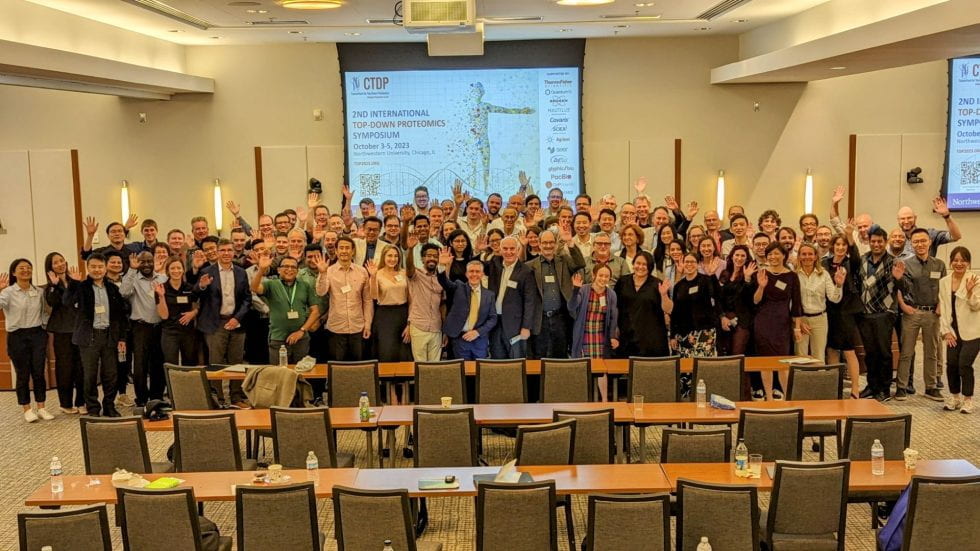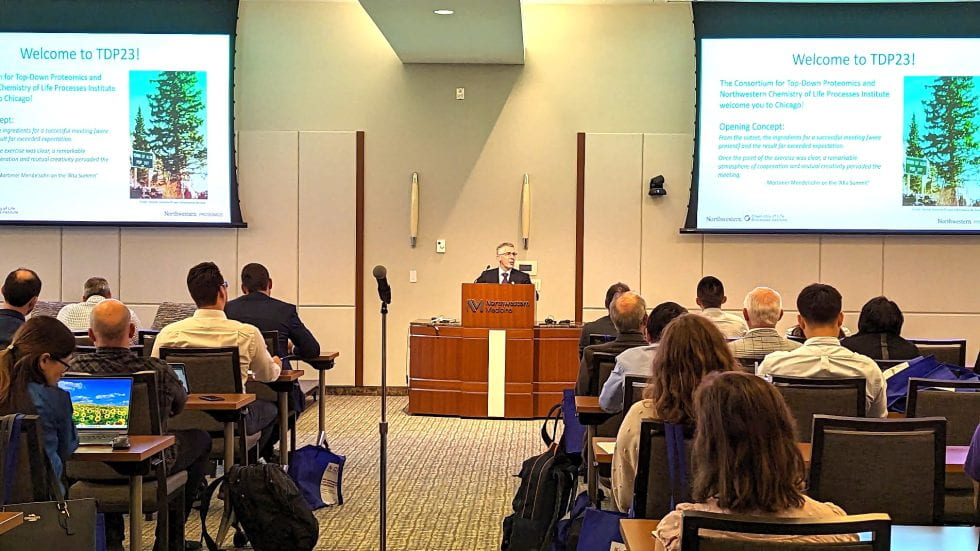
One hundred and sixty world leaders in proteomics, proteoform biology, cell biology and genomics gathered October 3-5, 2023, at Northwestern’s Prentice Women’s Hospital to present their latest research findings and discuss next-generation proteomics at the second International Top-Down Proteomics Symposium. The Symposium was hosted by the Consortium for Top-Down Proteomics (CTDP) together with Northwestern University’s Chemistry of Life Processes Institute (CLP).
“Community is a key aspect of science. A strong, cohesive group can catalyze transformative leaps in science and technology – precisely what this community is targeting,” says Northwestern’s Neil L. Kelleher, PhD, Walter and Mary E. Glass Professor of Molecular Biosciences; Professor of Chemistry,; and Professor of Medicine.
Proteins play a central role in maintaining and regulating human health. When proteins confront a challenging environment, disease and illness can result. Scientists are increasingly looking to proteoforms, the exact molecular forms of proteins, as the strongest link between our genes and disease.
“The field of top-down proteomics has advanced tremendously in the last four years. We see new technologies arising and a great future for mass spectrometry to target and tackle proteoforms,” says Julia Chamot-Rooke (Institut Pasteur). “We need to find proteoforms that are associated with disease, and then we’ll be able to develop new clinical assays and understand both the biology of some system organisms, but also how disease progresses and how we can stop it.”
Determination of the precise composition and function of each proteoform within the human body, an approach known as top-down proteomics, enables scientists to identify the true culprits behind disease and develop better targets to eliminate them.
Thirty-six scientific leaders presented and participated in Symposium round tables that covered a diverse range of topics from top-down proteomics approaches and single-molecule sequencing to the clinical value of proteoforms and the advancement of Human Proteoform Project, an ambitious effort to define all of the different forms of proteins in the human body. The Symposium also featured a series of poster and oral presentations covering single-cell methods, proteoform function and complexes, spatial mapping, and clinical applications as well as newer emerging approaches of proteoform analysis such as nanopore protein sequencing, microfluidics, and single molecule protein sequencing.
“You really need to have a few good examples of top-down proteomics that address biological questions to solve clinical problems. That’s what taxpayers want to see. They don’t want to see the numbers or fancy published papers. They want to know—the patient wants to know, ‘Can you treat my disease?’,” says Ying Ge (University of Wisconsin-Madison).
Presenters included Kelleher, the Director of the Chemistry of Life Processes Institute and chair of the TDP2023 Symposium, who shared new approaches to digitizing proteoform biology with single-molecule mass spectrometry. Ben Cravatt (Scripps Research Institute) presented chemical proteomics strategies to discover proteoform-specific small-molecule probes. David Walt (Harvard University) presented hypothesis-driven ultrasensitive methods for the discovery and validation of proteoforms. Amy Herr (University of California-Berkeley and the Chan Zuckerberg Biohub) presented single-cell analysis tools capable of resolving proteoforms and integrating this information into single-cell-omic analysis.

The Symposium was generously supported by sponsorships from Bruker, Quantum-Si, SCIEX, Thermo Fisher Scientific, Nautilus Biotechnology, Glyphic Biotechnologies, PacBio, Seer, Agilent, ZefSci, Covaris, CMP Scientific, and Affinisep.
“We are excited to see this level of enthusiasm for advancing the study and impact of proteoforms,” said CTDP CEO Paul Danis. “The momentum from this meeting will propel us forward towards even more wonderful developments and discoveries.”

